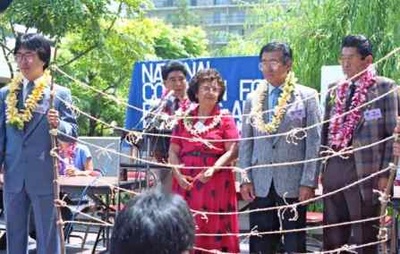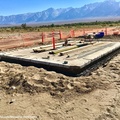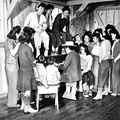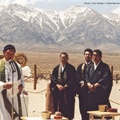Last April, at the Manzanar At Dusk program that follows the annual Manzanar Pilgrimage, when participants broke up into small groups to share their stories and insights about Manzanar, the Japanese American Internment experience, and how it remains relevant today, one thing struck me…
For the first time in the history of the program, we did not have enough former Japanese American concentration camp prisoners to go around.

Glen Kitayama (far left) joins NCRR members, including Frank Emi (second from right) during a Los Angeles press conference hailing the signing of the Civil Liberties Act of 1988 on August 10, 1988. Photo: Gann Matsuda
At this event, young people, mostly college students, gather to share their feelings and insights about what they experienced at the Pilgrimage, and about the issues surrounding the camp experience. But, most of all, they come to the event to hear the stories directly from those who were forced to live behind barbed wire for more than three years, deprived of their constitutional rights.
This year, that was a tremendous challenge because there were considerably fewer of them in attendance. Nevertheless, as the Manzanar Committee usually does, we scrambled to tweak the program, combining some of the groups, making them larger than is ideal. But we did the best we could to get at least one former prisoner in each group so that they would be able to share their stories with an audience that would be glued to every word they spoke, every gesture they made.
As the co-coordinator of the event, my only concerns were that the program was running smoothly and that our guests were getting as much out of the program as possible.
That left no time for me to dwell on the sobering fact that so few of the Nisei (second generation Japanese Americans, American citizens by birth; children of the first generation Issei, born in Japan), especially those who were imprisoned in American concentration camps such as Manzanar, Tule Lake, Poston, Topaz and Heart Mountain, among other camps and confinement sites, are still with us.
Since that time, I must admit that I have not given that fact much thought. But, a couple of days ago, that fact was thrust into the forefront of my thoughts when I learned of the December 1 death of Frank Seishi Emi at the age of 94.
But before I share my own reflections, a good friend of mine, Glen Kitayama, who met Emi around the same time that I did—back when we were in our twenties—and worked more closely with him, shared his own thoughts.
“I was aware that my family and other Japanese Americans living on the West Coast were imprisoned in concentration camps during World War II,” said Glen. “Like many other Sansei (third generation Japanese Americans) my age, I had heard about the camps at the dinner table, but the conversations always focused on the social connections that my family had with other Issei and Nisei. The camps were always an easy point of reference in which others could find common ground.”
“When I was a young kid, I had the distinct impression that the camps were a fun place to be since everyone seemed to know each other so well,” added Glen.
Thinking that the camps were a fun place to be is a common misconception among young Japanese Americans because so few of the former prisoners freely speak of their experiences, and even when they do, they often talk only about the fun times or whatever positive experiences they had—speaking of the suffering, injustice and hardship often brings back too much pain.
“As I grew older and began to understand the realities of the camps, I grew angry and decided that I wanted to learn more about the issue and do something about it,” Glen noted. “I also wondered where our heroes were in the Japanese American community.”
“Where were our Rosa Parks, Martin Luther King’s, Malcolm X’s, Cesar Chavez’s? As far as I knew, we didn’t have any heroes who stood up for justice while the government herded us away and locked us up in the desert behind barbed wire,” Glen added.
Glen’s anger and desire for action led him to join the National Coalition for Redress/Reparations (NCRR; now know as Nikkei For Civil Rights and Redress), where he had the good fortune to meet and work with Emi.
“My view began to change when I joined the NCRR in the Eighties,” said Glen. “I met Frank Emi and learned about his experience at the Heart Mountain Concentration Camp as one of the leaders of the Fair Play Committee. While his story is fairly well known now in the Japanese American community, it was pretty unknown to many Sansei and Yonsei (fourth generation Japanese Americans) in the Eighties.”
“Frank Emi and the other Heart Mountain draft resisters were pariahs in the community because they refused to be drafted into the army until their constitutional rights were restored as American citizens,” added Glen. “How amazing was that? Frank and the Fair Play Committee took a principled stand against the draft even though the established leadership in the community opposed them and labeled them as ‘troublemakers.’”
As Glen learned Emi’s story, he quickly began to view him as a hero.
“Frank and the other leaders in the Fair Play Committee refused to be drafted even though they knew it meant they would be separated from their families and sent to a federal prison,” Glen said. “They did this knowing that they would be labeled by many as traitors to their country and their own community. Heck, looking back on it, even Malcolm X had a dedicated group of supporters who believed in the same cause. Outside of family and friends, where was the support for Frank Emi and the Fair Play Committee?”
“To me, that’s what makes Frank Emi a true American hero.” Glen stressed. “He didn’t lose his moral compass in a time of great crisis. He had the courage to stand up for his beliefs when everyone else was willing to go along with the crowd and not cause any trouble.”
“When I talk with young college students about Frank Emi and the Fair Play Committee, I often hear them say that they would have done the exact same thing that Frank did during the war. And when I hear that, I often laugh to myself because I know that it’s not true. Frank Emi is the person that all of us want to be when the chips are down. Unfortunately, most of us fall short when confronted with a crisis of the magnitude that Frank Emi faced.”
Although our paths would cross at UCLA when Glen became a graduate student in Asian American Studies and History and became a fellow member of the UCLA Nikkei Student Union (NSU), my journey to activism took a different road. But, as in Glen’s case, Emi quickly became one of my heroes.

Frank Emi (left), Aiko Herzig-Yoshinaga (center) and Dale Minami (right) spoke at a UCLA forum on the Japanese American Internment experience during the UCLA Nikkei Student Union's Week of Remembrance in February, 1986. Photo: Gann Matsuda
I first met Emi back in February 1986, when I invited him to speak at a UCLA forum on the Japanese American Internment experience during my days with NSU.
That forum, held during our “Week of Remembrance” events dedicated to the camp experience and the fight for redress and reparations, featured Dale Minami and Aiko Herzig-Yoshinaga, along with Emi.
Talk about three of the heaviest of heavy hitters in the Japanese American community.
Minami was one of Fred Korematsu’s attorneys for his 1984 coram nobis case, and Herzig-Yoshinaga’s research in the National Archives uncovered evidence that was withheld from the United States Supreme Court in the 1944 cases of Korematsu, Gordon Hirabayashi and Minoru Yasui, who challenged the constitutionality of their imprisonment. Her research also provided much of the legal basis for the class-action lawsuit against the United States Government filed by the National Coalition for Japanese American Redress that sought $27 billion in damages on behalf of the more than 110,000 Japanese Americans who were imprisoned.
As for Emi, all I knew at the time was that he was a draft resister. In fact, I knew relatively little about the internment experience back then. It was a paragraph or two in my high school history book that was glossed over in a couple of minutes, if that. I had to do a lot of research prior to the Week of Remembrance to bone up for the events I was coordinating, and read a great deal about the camps, along with the exploits and heroism of the 442nd Regimental Combat Team/100th Battalion, the most decorated unit of its size in United States military history.
Like Glen, I became angry. How could our own government treat its own citizens like dirt? The racism! The suffering under horrible conditions in the camps…and those were just a few of the thoughts that raced through my mind.
But, as Glen noted, there was very little about the draft resisters. It was not until I listened to Emi speak at UCLA that I began to understand the significance of his actions, the tremendous courage it took to take that stand, especially under the circumstances, not to mention his strength of conviction.
When the event was over and after talking more with Emi, Herzig-Yoshinaga and Minami, I did not know it at the time, but I had three new heroes in my life.
Of course, if I were to write about the impact each has had on my life, this story would reach the length of a novel, especially since I have worked with and built relationships with Frank, Aiko and Dale since that 1986 event. But as the years passed and as I got to know Frank through helping out with events and programs sponsored by NCRR, I knew that he was, as Glen noted, a true American hero.
Indeed, whenever I had the great fortune of being able to talk with him (which was not often, unfortunately), Frank would tell me a story or anecdote about his life, whether it was related to him being a draft resister, teaching judo or just about life in general. Although it is fairly well known among those who knew him, I will always remember him telling me about when he, along with other members of the Fair Play Committee from Heart Mountain, were sent to the federal penitentiary at Leavenworth, Kansas.
Their fellow prisoners harassed them and threatened them physically, even pushed them around, and that may be understating what happened. But once the draft resisters put on a judo demonstration, all that stopped—they were given their space after that.
Frank became even more of a hero in my eyes for his work with NCRR in support of other communities facing racism and injustice, most recently, Muslim Americans facing racial profiling, or worse. Frank always stood up and spoke out in solidarity, drawing parallels to his own experiences.
When I look back at my years of being a community activist, I realize that Frank’s courage, strength of conviction, his consistent support of people fighting discrimination and injustice, on top of his experiences as a draft resister, are among the primary reasons that I became an activist, not only working on issues affecting the Japanese American community, but also the wider Asian Pacific American community and those of others facing injustice and inequality.
“Rest in Peace, Frank,” said Glen. “Your contributions to our community will never be forgotten.”
Couldn’t have said it better myself.
* Unattributed views expressed in this story are those of the author and are not necessarily those of the Manzanar Committee.
**This was originally published on the Official Blog of the Manzanar Committee on December 4, 2010.
* * *
Check Frank Emi's oral history interview >>
* * *
© 2010 Gann Matsuda





